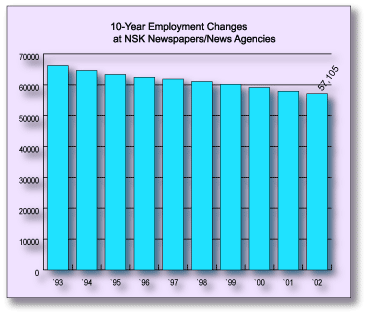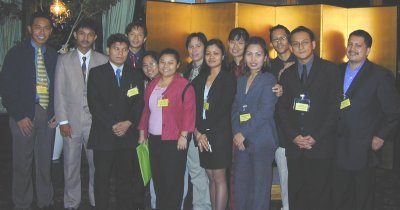NSK News Bulletin Online
Sep. 2002
-------------------------------------------------------------------
*NSK Announces 2002 Awards, Prepares for Newspaper Week
*Number of Newspaper, News Agency Employees falls to 57,000
*13 ASEAN Journalists Attend NSK Workshop
- - - - - - - - - - - - - - - - - - - - - - - - - - - - - - - - - - - - - -
*Topics
--Three Major Regional Papers To Develop Integrated Database
--Competition Up Among Chinese-Language Media in Japan
--Panel to Propose Substitutes for Foreign Words
- - - - - - - - - - - - - - - - - - - - - - - - - - - - - - - - - - - - - -
Story of the Month>>>
Advertising Down for 11th Straight Month
------------------------------------------------------------------
NSK Announces 2002 Awards, Prepares for Newspaper Week
The Nihon Shinbun Kyokai (NSK) board on Sept. 4 approved the winners of this year°«s NSK Awards and Newspaper Advertising Prizes. The selections came amid preparations for Newspaper Week, which starts on Oct. 15.
NSK Awards went to seven projects in the Editorial Division and two in Management/Business. Following up on the Sept. 11 attacks on the United States, award winners included a serial on the life and activities of suspected suicide pilot Muhammad Atta, a serial on terrorism and families, and scoop photos from the fall of Kabul under U.S. bombing (below photo).
 Shizuoka Prefecture, All Nippon Airways and the Japan Football Association are among the five advertiser recipients of this year°«s Newspaper Advertising Prizes. The Asahi Shimbun, Tokyo Shimbun, Yamagata Shimbun and two other newspaper companies won prizes for Newspaper Planning. Shizuoka Prefecture, All Nippon Airways and the Japan Football Association are among the five advertiser recipients of this year°«s Newspaper Advertising Prizes. The Asahi Shimbun, Tokyo Shimbun, Yamagata Shimbun and two other newspaper companies won prizes for Newspaper Planning.
Selected from among subscribers°« suggestions, this year°«s Newspaper Week has adopted the theme, °»We Want the Facts -- We Read Newspapers.°… The newspaper-delivery section has adopted the suggested theme, °»Delivering Today°«s Information and Tomorrow°«s Guidelines.°…
Newspaper Week starts on Oct. 15 with a series of events including the National Newspaper Convention at which the NSK Awards will be granted, a Newspaper Advertising Day and memorial local gatherings of newspaper readers.
The 55th annual National Newspaper Convention will be held at Nagoya International Convention Center in Nagoya City, Aichi Prefecture. In addition to the awards ceremony, there will be a keynote speech by Nagoya University Prof. Ryoji Noyori, last year°«s Nobel Prize winner for chemistry, and a panel discussion of top newspaper executives about the state of the newspaper business.
Newspaper Week°«s public events will include a Nagoya exhibit of Newspaper Photo Contest winners and invitational memorial gatherings of subscribers in Tokyo, Osaka, Nagoya and Fukuoka.
Newspaper Advertising Day, officially Oct. 20th, will be marked this year at the Palace Hotel in Tokyo°«s Chiyoda Ward on Oct. 18, as Oct. 20 falls on a Sunday. Various events for Newspaper Delivery Day and Newspaper Delivery Boys Day will be held across Japan on Oct. 20 to salute newspaper delivery workers and delivery boys and girls.
Here are the winners of this year°«s NSK Awards:
Ę£Editorial Division
ʶNews Section
Scoop on the Defense Agency°«s compilation of lists of the people who asked for information under the Disclosure of Information Law
(Tomoko Oji, City News Division, Mainichi Shimbun Tokyo Head Office)
ʶPhotography Section
Scoop photos on the fall of Kabul, Afghanistan
(Koji Harada, Photo Division, Kyodo News)
Video of North Korean asylum-seekers at Japan°«s Consulate General in Shenyang, China
(Hisashi Hirai, General Bureau in China, Kyodo News)
ʶFeature Section
Serial and related reports on the life of Muhammad Atta (XXXXX)
(Jinichi Matsumoto, staff editor, Asahi Shimbun Tokyo Head Office)
Serial on °»Terrorism and families°…
(Part I: New York, Japan and Afghanistan; Part II: Palestine and Israel)
(Masanori Toki, deputy chief, City News Division, Chunichi Shimbun, for the special task force on the project)
Campaign on hot-rodders
(Takashi Takamoto, city and business group, editorial department, Chugoku Shimbun, for the special task force on the hot-rodder problem)
Serial on Hepatitis C
(Mitsuyoshi Atsuta, editor, News Japan, News Center, News Bureau, Fuji TV)
Ę£Management/Business Division
Administrative reform through a Web-based total system
(Kensuke Kosaka, president, Shinano-Mainichi Shimbun)
E-transmission of digital ad copy to keep ad info in step with editorial content
(Junji Nakamura, general manager, advertising department, Chunichi Shimbun, Nagoya Head Office)
Number of Newspaper, News Agency Employees falls to 57,000
An NSK survey says the number of people working at NSK°«s 106 member newspapers and news agencies as of April 1st was 57,105, down 755 people, or 1.3 percent, from 2001.
Employment in Japan°«s newspaper industry began a long-term decline around 1980, although it temporarily rebounded in 1988 at the height of the so-called °»bubble economy.°… After peaking at 66,250 in 1993, total employment fell 2.4 percent in 1994 and has since fallen each year by about 1 percent. Over the past 10 years, total employment has fallen by 9,145 people, or 13.8 percent.
The 76 companies that gave detailed survey replies said male employees outnumbered females by 48,409 to 5,606 respectively, for a total of 54,015. Men account for 89.6 percent and women 10.4 percent. The average employee°«s age is 41.2 years.
There are 20,851 reporters (2,384 women represent 11.4 percent).
By job type, the editorial department accounts for 44.5 percent of the total, followed by production/printing/forwarding at 18.3 percent, sales at 14.3 percent, publishing/business/electronic°°media°°at 6.7 percent, supervising/administration at 8.4 percent and all others together at 7.9 percent. Over the past 10 years, the production/printing/forwarding employment share has fallen 9.0 percentage points, while publishing, business, electronic media and others have all tended to grow.

13 ASEAN Journalists Attend NSK Workshop
The 25th ASEAN Journalists Training Project began a one-month workshop in Japan on Sept. 6. A total of 1£≥°°journalists from Indonesia, Malaysia, the Philippines, Thailand, Vietnam and Laos ? arrived in Japan on Sept. 5 to begin a 29-day workshop on the theme, °»Japanese Society Merging with Asian Culture.°…
Experts will brief the visiting ASEAN journalists about Japan°«s food culture, movies, comics, animation, Kyogen play and other topics. Top Mainichi and Nikkei editorial officials will brief them about Japan°«s political and economic situation and they will make courtesy visits to the Japan Newspaper Museum, NHK and the Oita-Godo Shimbun.
In the latter half of their itinerary, the visiting journalists will travel to Fukuoka, Nara and Kyoto for independent newsgathering.

The workshop participants are:
Mr. Benny Siga Butarbutar, Reporter/Coordinator, Antara (Indonesia)
Mr. Dedi Sahputra, Reporter, Waspada Daily (Indonesia)
Mr. Anoulack Khammalavong, Assistant Editor, Vientiane Times (Laos)
Ms. Simanithone Malivarn, Deputy Head of the English Service, Lao National Radio (Laos)
Ms. Ng Li San, Reporter, Sin Chen Daily (Malaysia)
Mr. Yushaimi Maulud bin Yahaya, Journalist, Malay Mail (Malaysia)
Mr. Adolfo Ares P. Gutierrez, News Editor, People's Taliba (Philippines)
Ms. Maria Aurea Leis Calica, Reporter, Philippine Star (Philippines)
Mr. Chairul Fahmy Hussaini, Journalist, Berita Harian (Singapore)
Ms. Rowena Heng Jee Kian, Journalist, Lianhe Wanbao (Singapore)
Mr. Bamrung Amnatcharoenrit, News Reporter, Bangkok Post (Thailand)
Ms. Wanwisa Choochon, Reporter, Thairath Daily (Thailand)
Ms. Nguyen Thu Hoai, Assistant/International Relations, Vietnam Journalists Association (Vietnam)
Topics.......Topics.......Topics........
|
Three Major Regional Papers To Develop Integrated Database
The Kyoto Shimbun, Kobe Shimbun and Chugoku Shimbun on Sept. 5 said they will develop an integrated database of articles, photos and page images. The three major regional newspapers signed a memorandum on the project at the head office of the Kyoto Shimbun.
They aim to launch the database by June 2002, starting with in-house use and then exploring the feasibility of commercialization.
IBM Japan has been engaged to develop the integrated database in the first such project in Japan°«s newspaper industry. The newspapers are to invite other regional newspapers to join the project to reinforce links among newspapers aiming to survive ever-intensifying competition.
The integrated database project is motivated by a desire to cut the costs of initial investment and maintenance, to save labor in management and operation of the database, and to accommodate NewsML ?new standard for electronic transmission of texts, photos, sound and images.
The database will be designed with a common-use base and optional capabilities for each company°«s particular needs. The main portion of the database will be stored at an IBM Japan-affiliated data center known for low maintenance fees and high data protection from earthquakes and other natural disasters.
The three newspapers are to evenly split the operating costs and the fees for line connections between the database center and their respective head offices.
The papers agreed upon the joint project as the renewal date approached for their internal database schemes, launching a feasibility probe last year. Starting this past January, they have held regular direct consultations. They have decided to collaborate on the joint integrated database while continuing their own respective database-related projects.
|
The Kyoto Shimbun is based in Kyoto City, Kyoto Prefecture, where it publishes daily newspaper as a set of morning and evening edition with a circulation of about 502,000. |
|
|
|
The Kobe Shimbun is based in Kobe City, Hyogo Prefecture, where it publishes daily newspaper as a set of morning and evening edition with a circulation of about 551,000. |
|
|
|
The Cugoku Shimbun is based in Hiroshima City, Hiroshima Prefecture, where it publishes daily newspaper as a set of morning and evening edition with a circulation of about 736,000. |
Competition Up Among Chinese-Language Media in Japan
There are a growing number of newspapers, magazines and TV or radio programs being offered in the Chinese-language for the roughly 380,000 resident Chinese in Japan.
With new interests now poised to enter the growing market for Chinese-language media, a wave of shake-out competition is expected.
According to media experts, about 30 newspapers and magazines are being published in the Chinese language in Japan. Three broadcasters run five TV channels in Chinese over CS satellite and radio channels are due soon.
The Chinese Review Weekly (Chubun Do-ho) is the largest such newspaper, with a claimed circulation of 80,000 copies. The publication is available in Tokyo convenience stores and the Kiosk chain of subway shops.
Wu Yue-ming, 42, is the deputy editor of the Chinese Review Weekly. °»We are not a spokesman for China. We are set up to report what we believe is true, in an objective manner, from the perspectives of resident Chinese in Japan.°…
°»Raku Raku China°… is a CS satellite TV channel that went into service in 1998. It claims a subscriber total of 20,000. Mainly intended for resident Chinese, the channel also provides popular TV programs to Taiwan and Hong Kong. Channel officials plan to air programs subtitled in Japanese to draw Japanese subscribers. They also plan to produce access programs to present a °»life-size Japan°… to viewers in China. A female Chinese program director with the TV station said the service is in a transitional period. °»It is important for us to enhance the uniqueness of our channel in Japanese society,°… she said.
Duan Yue-zhong, a resident Chinese expert on media for Chinese people, said, °»At present, there are too many China-language media players in the market. Competition should drive out the lower-quality media.°…° Kyodo°ň
Panel to Propose Substitutes for Foreign Words
The National Language Research Institute on Aug. 7 held a first meeting of its newly created panel on foreign words.
The research institute is affiliated with the Education, Science, Sports and Technology Ministry. It formed its foreign-word panel in June at the suggestion of Education Minister Atsuko Toyama, to consider Japanese substitutes for difficult-to-understand foreign words.
The institute recently named panel members comprising scholars, writers and translators, experts on house style from the Asahi Shimbun and the Yomiuri Shimbun, as well as a chief researcher from NHK°«s Broadcasting Culture Research Institute.
The panel is to study the annual reports, newspapers, magazines and other publications of government ministries and agencies to try to agree how to substitute simplified Japanese terms for complex foreign words.
The panel is starting by examining the foreign words used in government white papers, along with other words specifically cited by panel members. The panel is due to draft a set of proposals by the end of this year, suggesting how to substitute Japanese for key foreign loan words.
|
<< back
Story of the month>>>>
Advertising Down for 11th Straight Monthm |
|
The volume of advertising placed in Japan°«s mass media continues to plunge at an alarming pace. The decline is most extreme in the newspaper market and shows no sign of recovery.
Dentsu Inc., a major ad agency, recently released a survey on advertising in newspapers, magazines, TV and radio. The survey covers the period of January-June 2002.
The survey says that the year-on-year advertising drop that all media experienced in the July-December 2001 period has been followed by yet another year-on-year decline across the board.
The continued weakness of the Japanese economy, worsening corporate earnings and dwindling demand for information technology (IT) has led to a business trend of cutting spending on advertising.
By industry, advertising for information/telecommunications, autos, food/beverages and fast-food all fell compared to the first half of 2001, in all four categories of media.
The volume of advertising placed in a total of 121 surveyed newspapers dropped 4.4 percent compared to the previous first half, making it the second such drop in a row for the half-year periods. Breaking the trend however, advertising in sports newspapers edged up with brisk orders for color and spread-pages. But general-interest newspapers, both national and regional, more than counterbalanced the sports-paper ad rise. Classified ads, most of them for °∆help-wanted°«, plummeted 4.5 percent in a fourth straight half-yearly decline.
On a monthly basis, the Dentsu survey says newspaper advertising was down 5.0 percent in July 2002 compared to July 2001. That now makes it 11 straight months in which advertising has declined.
Despite the World Cup soccer finals, advertising in all four categories of media fell 3.5 percent in May and June compared to the same months last year. The decline was amplified by the relatively good advertising figures reported for the same months in 2001. Surprisingly, corporations failed to increase their TV advertising to try to take advantage of the extraordinarily high TV viewer rates during the Word Cup.
A survey by the Ministry of Economy, Trade and Industry said newspapers°« advertising revenues fell a staggering 22.3 percent in March and 18.7 percent in May from the same months in 2001. It also said that the monetary loss by newspapers exceeded that suffered by TV, magazines and radio broadcasters.
The benchmark Nikkei average dipped below the Y9000 mark in early September, raising new doubts about the prospects for an economic recovery.
Under the circumstances, newspapers are doing whatever they can to built up advertising. One effort is to transmit ad copy digitally. Ad agencies have begun online transmissions of digitalized ad copy to newspapers. Electronic transmission saves money over the old film-based transfer system. It also cuts the lag from the production until the placement of an ad in a newspaper, giving advertisers the chance to feature the very latest information.
Some innovative newspapers, including the Chunichi Shimbun, which this year won NSK°«s Management/Business award, have been working toward this goal, together with ad agencies, since the latter 1990s.
Newspapers can now publish evening-edition ads that incorporate weather forecasts from the morning of the same day. Announcement ads for events can use photos from the venue taken just the day before. Advertisers are keen about °»newsy°… ads that stay current with each edition°«s editorial content.
Incorporating the latest market information or updated accounting data in ad copy and developing more creative ads in general are critical tasks in the effort to recoup advertising earnings. Coupled with the online transmission of digitalized ad copy, these initiatives can be expected to generate new opportunities in newspaper advertising.
|
|
<< back
|
Nihon Shinbun Kyokai
The Japan Newspaper Publishers & Editors Association
Nippon Press Center Bldg., 2-2-1 Uchisaiwai-cho, Chiyoda-ku,
Tokyo100-8543, Japan
bulletin@pressnet.or.jp.
Copyright 2002 Nihon Shinbun Kyokai
All right reserved
|
|
|
|
 Shizuoka Prefecture, All Nippon Airways and the Japan Football Association are among the five advertiser recipients of this year°«s Newspaper Advertising Prizes. The Asahi Shimbun, Tokyo Shimbun, Yamagata Shimbun and two other newspaper companies won prizes for Newspaper Planning.
Shizuoka Prefecture, All Nippon Airways and the Japan Football Association are among the five advertiser recipients of this year°«s Newspaper Advertising Prizes. The Asahi Shimbun, Tokyo Shimbun, Yamagata Shimbun and two other newspaper companies won prizes for Newspaper Planning.
